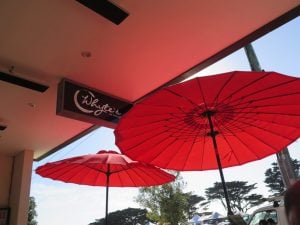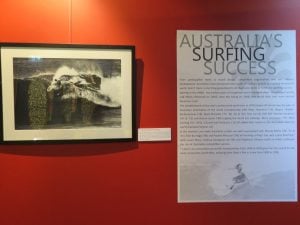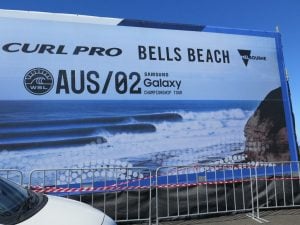Some of the fabulous memorabilia in the Australian National Surfing Museum – [if you have a touch screen you can enlarge to read the crazy notes on the boards!]
20 March 2016
On our way to breakfast, we called to Point Danger Marine Sanctuary at Torquay, the reef is ideal for snorkelling and exploring the diverse marine life at low tide. The area between Torquay’s back and front beaches is formed of beds of crumbling limestone and a narrow rock platform which extends to the west. A small reef which is only exposed at the lowest of summer tides lies just offshore and is often isolated from the beach by a deep sandy channel. One shipwreck is found within the park, the Joseph H. Scammell.
Back Beach at Torquay looking south from Point Danger Marine Park
The limestone reef is an enthralling feature of this park. Covered in small boulders and intricate seaweed beds, the reef is home to a number of weird and wonderful creatures. Most noteworthy is the huge diversity of seaslugs, currently 96 species known to occur in this sanctuary, many of which are endemic. These fascinating creatures can be any colour of the rainbow and come in a range of exquisite shapes and sizes. Also present are carnivorous worms, delicate brittle stars and majestic eagle rays. The Point has great views north and south.
 We then headed for the Torquay cafe scene and had breakfast at Whyte’s Cafe on the beach front (right). There were markets along the foreshore, and lots of people crowding around at the various stalls.
We then headed for the Torquay cafe scene and had breakfast at Whyte’s Cafe on the beach front (right). There were markets along the foreshore, and lots of people crowding around at the various stalls.
A must was a visit to the Australian National Surfing Museum, the largest surfing museum in the world. The Museum itself is surrounded by numerous well known brand surfing stores. We probably spent the best part of thirty minutes browsing through the Museum, particularly pleased to see many photos of Newcastle’s Mark Richards as well as other well known surfers over the years.
A favourite of surfers, the Kombi waggon (top left), Mark Richards from Newcastle, 4 times World Champion (1979-1982 (top right), surfboards over the years (bottom left), Hall of Fame (bottom right)
After leaving Torquay our first stop was the famous Bells Beach, preparing for their Rip Curl Pro from 24 March until 5 April. Huge stands were being erected for some of the thousands who will no doubt line the hills around Bells to watch the champions in action (below left and right).
Further south we stopped at Point Addis (below). At the base of 20 m high Point Addis is a narrow, 80m long, sand beach, which is awash at high tide and fronted by rocks and reef flats at low tide. It can only be reached with difficulty around the rocks and is not recommended for bathing, but very spectacular to view!
Further south we stopped at Anglesea, a particularly significant town on the Great Ocean Road as it marks the first spot south-west of the road’s official start at Torquay where it meets the coast (below left and right). Patrolled surf and swimming beaches surrounded by beautiful forest and coastal scenery make Anglesea a popular tourist resort with the vast expanse of sand surrounding the mouth of the Anglesea River being a popular spot for swimmers. Other scenic spots along the coast include the rocky Point Roadknight and the lookouts off Harvey Street and the Great Ocean Road above the town’s main surf beach. Attractive parks and gardens line the coastal foreshore and the Anglesea River, with Coogoorah Park at the end of River Reserve Road featuring a network of islands linked by boardwalks and bridges through wetlands.
Close to Anglesea and heading further south is the pretty Point Roadknight beach, then further south is Airey’s Inlet. The boutique coastal town is one of the Great Ocean Road’s best kept secrets, offering visitors serenity and tranquility with spectacular cliffs, beautiful beaches, a picturesque river valley and the Great Otway National Park as a scenic backdrop. Aireys Inlet is becoming vastly recognised for its live music & entertainment, arts events & culture and its flourishing literary hub.
Next stop a little further south was Split Point Lighthouse, which has some of the best views on the coast and a fascinating history. The Split Point Lighthouse dominates the Aireys Inlet landscape, its 34 metre high tower and typical red cap visible for miles. The still operating lighthouse is open to the public with guided tours available and sweeping views of the Eagle Rock Marine Sanctuary and Great Ocean Road region below. The grounds surrounding the lighthouse include a replica of the ‘bark hut’ early settlers in Aireys Inlet would have lived in, and the beach at the base of the lighthouse has great rockpools to explore. The quaint Willows Tea House (above left) is close to the light house, and a small band was playing for the patrons.
At the base of the Split Point Lighthouse, the 17 hectare Eagle Rock Marine Sanctuary is home to a huge variety of marine life. Popular with snorkelers and scuba divers, you can expect to see a diverse range of invertebrates. The rockpools around the sandy coves in this area are also teeming with marine life and are terrific for families to explore.
Lorne was the next stop along the wonderful Great Ocean Road, and we had to stop and take a photo of a lone rock fisherman was relaxing in a chair with several rods set up, just waiting for the first bite! We passed under the Memorial Arch (right) and then took a turn to Teddy’s Lookout, about 8 kms out of town. It was a really delightful spot and we saw lots of kookaburras and magpies on our walk to the Lookout over the St George estuary flowing into the ocean (below). We were really pleased that we had followed the recommendation to visit this peaceful place.
Not far from Teddy’s Lookout were the signs to the Erskine Falls and we decided to follow the road to the upper lookout of the falls. It is a heavily wooded area with very tall trees, so any photograph would not truly reflect the tall falls.
We returned to Lorne and parked in the main street looking over the beach, and watching some cockatoos performing on the main street (below right). A little further along we came across the Lorne Pier (below left), the turnoff is opposite the wonderful old Grand Pacific Hotel.
Built in the 1870’s as one of the first hotels along the Great Ocean Road. Victoria’s Lieutenant-Governor declared the Great Ocean Road officially open at a ceremony near Lorne’s Grand Pacific Hotel, the site where the project’s first survey peg had also been hammered into the ground 14 years before. The Pier became a new focal point for the town’s people, especially after Henry Gwynne built the impressive three-storey Grand Pacific Hotel. Henry Gwynne suffered a serious blow-out of costs during construction and the estimated $12,000 ended up costing $24,000. On opening day, in January, Cobb and Co Coaches provided a special express services for early guests.
Originally it was accessed only by sea with superb views in one of the most unique settings on the coast, opposite the Lorne pier. It has been fully restored and now offers all modern services in a classic restored building.
 The day was moving along, and we had forgotten to have lunch! However we continued on the Great Ocean Road, where it has some spectacular bends between Lorne and our destination of Apollo Bay. We passed through Separation Creek and Wye River and it was sad to see the blackened trees where the recent bushfires had caused such devastation. We passed through Point Defiance, Godfrey Creek (where there was a ship wreck in 1891 and some parts of the ship can still be seen at low tide), Cape Patton Lookout about 20kms north of Apollo Bay – finally arriving at our destination (right).
The day was moving along, and we had forgotten to have lunch! However we continued on the Great Ocean Road, where it has some spectacular bends between Lorne and our destination of Apollo Bay. We passed through Separation Creek and Wye River and it was sad to see the blackened trees where the recent bushfires had caused such devastation. We passed through Point Defiance, Godfrey Creek (where there was a ship wreck in 1891 and some parts of the ship can still be seen at low tide), Cape Patton Lookout about 20kms north of Apollo Bay – finally arriving at our destination (right).
After settling in to our motel, I had a 15 minute catnap (this type of driving can be exhausting with several stops to see the wonderful scenery!) then we drove to the Great Ocean Road Brewhouse for dinner.
Tomorrow we will have a better look around Apollo Bay, then a busy day ahead driving further along the Great Ocean Road to our next destination of Port Fairy.
Check out the Tastes page for our meal at Apollo Bay here



















